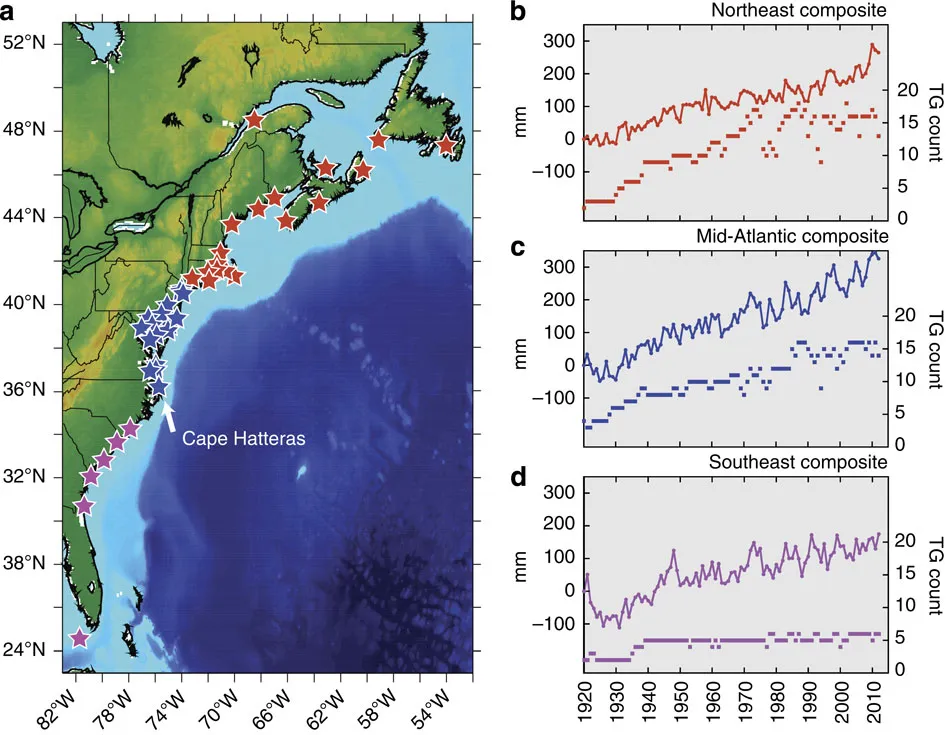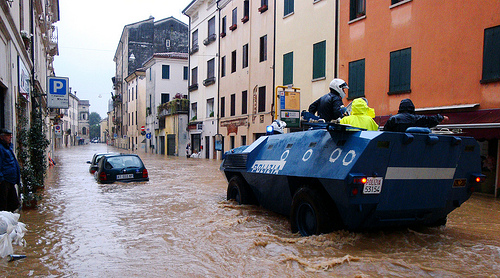What is causing the seas to rise?
We hear a lot about sea level rise in the context of climate change. But what are the mechanisms by which the water is rising? There are three factors:
- thermal expansion - warmer water takes up more room. Given that the oceans are absorbing upwards of 90% of the additional heat in our changing climate, it makes sense that these waters are warming and therefore expanding.This accounts for about half of observed sea level rise (Nerem et al., 2019).
- mountain glaciers - typically, we expect to see intra-annual variation in the size of various glaciers around the world. They tend to melt off a bit in the summer months but then make back up for it with snow in the colder months and maintain a fairly steady state over time. But summer glacier melt is currently outpacing winter glacier growth since the springs and summers are warmer (Glick, n.d.)
- Greenland and Antarctic ice sheets - the same heat that's giving the glaciers trouble is impacting the huge ice sheets over Greenland and Antarctica. In Greenland, the meltwater attacks from above and sea water from below to make it easier for ice streams to flow.The West Antarctic ice sheet is usually the one that gets the most attention because it's melting so rapidly and is widely considered the most vulnerable of the three (Fox, 2017).The science is frankly less clear about what's happening with the East Antarctic ice sheet.
- For example, a study published in Nature last year suggests that the East Antarctic sheet may have added 5 billion tons per year between 1992-2017, though the certainty surrounding this estimate is, by their own admission, fairly weak compared to other findings about the West Antarctic sheet (The IMBIE Team, 2018).
- A newer study (Rignot et al., 2019) in the Proceedings of the National Academy of Sciences used 40 years of satellite data to evaluate the ice sheets and finds that East Antarctica was contributing almost a third of Antarctica's total contribution to global sea level rise.
- The important thing to understand about these possibly quite conflicting recent studies of the Antarctic ice sheets is that regardless of 'which one is right', the destabilization of the world's three largest ice sheets has potentially dramatic impacts on our coasts and the cities that often inhabit them. Perhaps there is no greater example, either, of the consequences of reaching tipping points. Once these ice sheets become destabilized, it's hard to get them back. Remember, too, that even if we turned off every fossil-fuel emitting source in the world right now, those extra greenhouse gases would be lingering in our atmosphere for decades or longer, creating additional warming.
To further complicate an already complex matter, these changes in ice volume aren't happening in a vacuum. NASA has this nice visualization (I couldn't figure out how to embed it here, but please go review it, it's only 1:08 minutes long) of the snowfall Antarctica experienced over the 20th century. As it turns out, because many parts of Antarctica saw increased snowfall, this helped mitigate the sea level rise we would have otherwise expected (by their estimates, this amounted to about 0.4 inches).
Where do these higher waters go?
As sea level rises, it pushes inland. How far it penetrates depends on the interplay of several factors.
- Regional physical geography: Sea level rising along a flat-lying coastline can push far inland, whereas sea level rise on a steep shoreline makes little appreciable difference.
- Regional tectonic activity: If coastal land is sinking for tectonic reasons, sea level rises faster, but if the land is rising due to Earth movements, sea level might actually fall.
- Local coastal currents can also make a difference, enhancing or suppressing sea level rise caused by climate change.
Along the Mid-Atlantic coastline from about New York City to Cape Hatteras, North Carolina, the combination of climate change-induced sea level rise, a rapidly sinking coastline, coastal currents that reinforce sea level rise, and a very broad, flat coastal shelf results in relative sea level rise that is about twice the global average.

Physical Impacts Caused by Sea Level Rise
- As ocean water pushes inland, it increasingly inundates the coastal zone. The pressure exerted by the rising sea pushes saltwater further upriver and causes saltwater to intrude into coastal aquifers, degrading water quality and sometimes making water unfit for human use.
- When storms strike the coastline, they are working from a higher baseline, so waves and storm surges penetrate further inland, causing more damage than before.
- The greater penetration of waves results in increased coastal erosion.
- Coastal ecosystems have evolved to migrate inland as sea level rises, but because the rate of sea level rise is so rapid, some ecosystems cannot migrate fast enough. Of the ecosystems that can respond to rapid sea level rise, many confront barriers erected by nature or, more likely, by humans; roads, buildings, and other structures effectively squeeze migrating ecosystems, barring them from escaping the rising seas.

